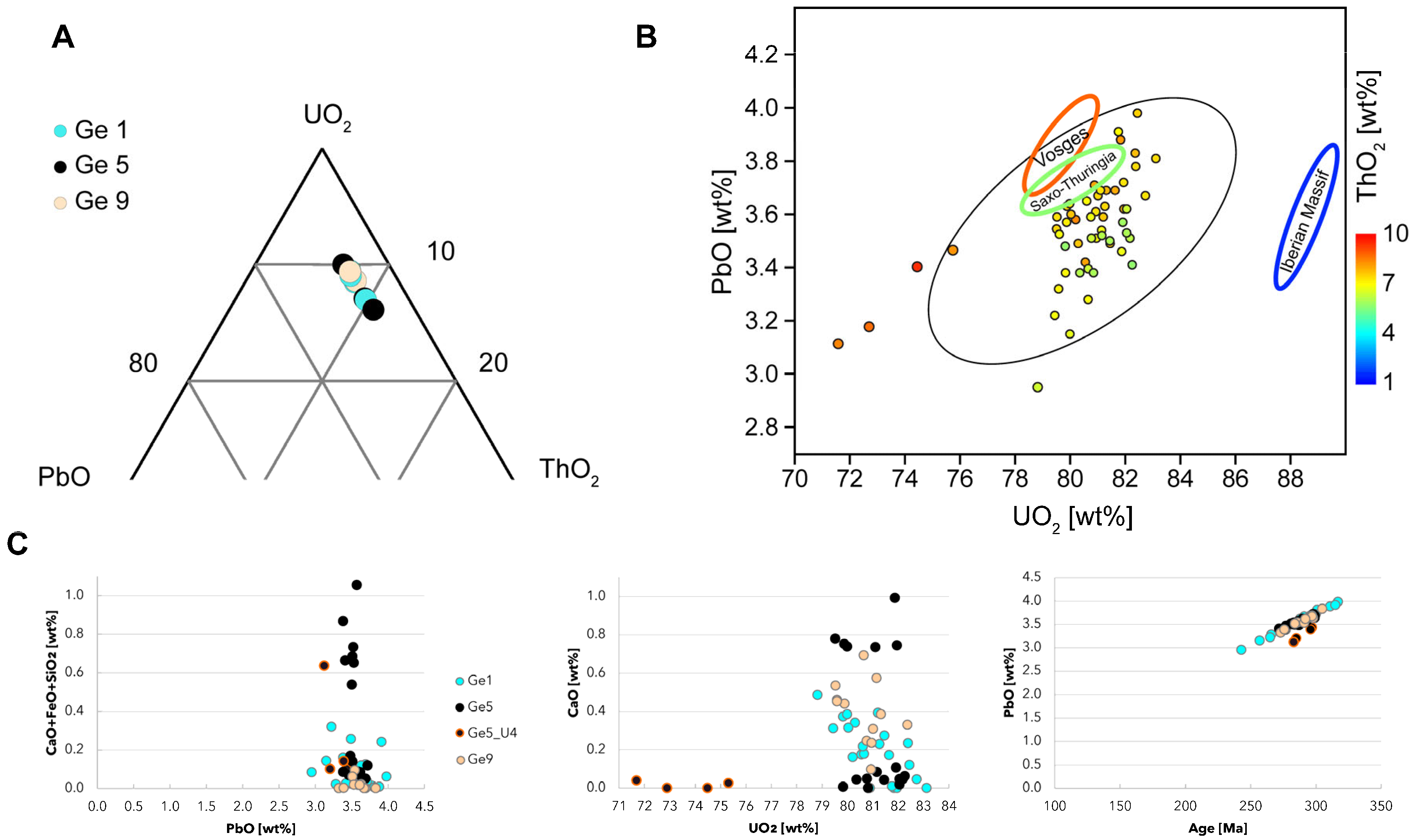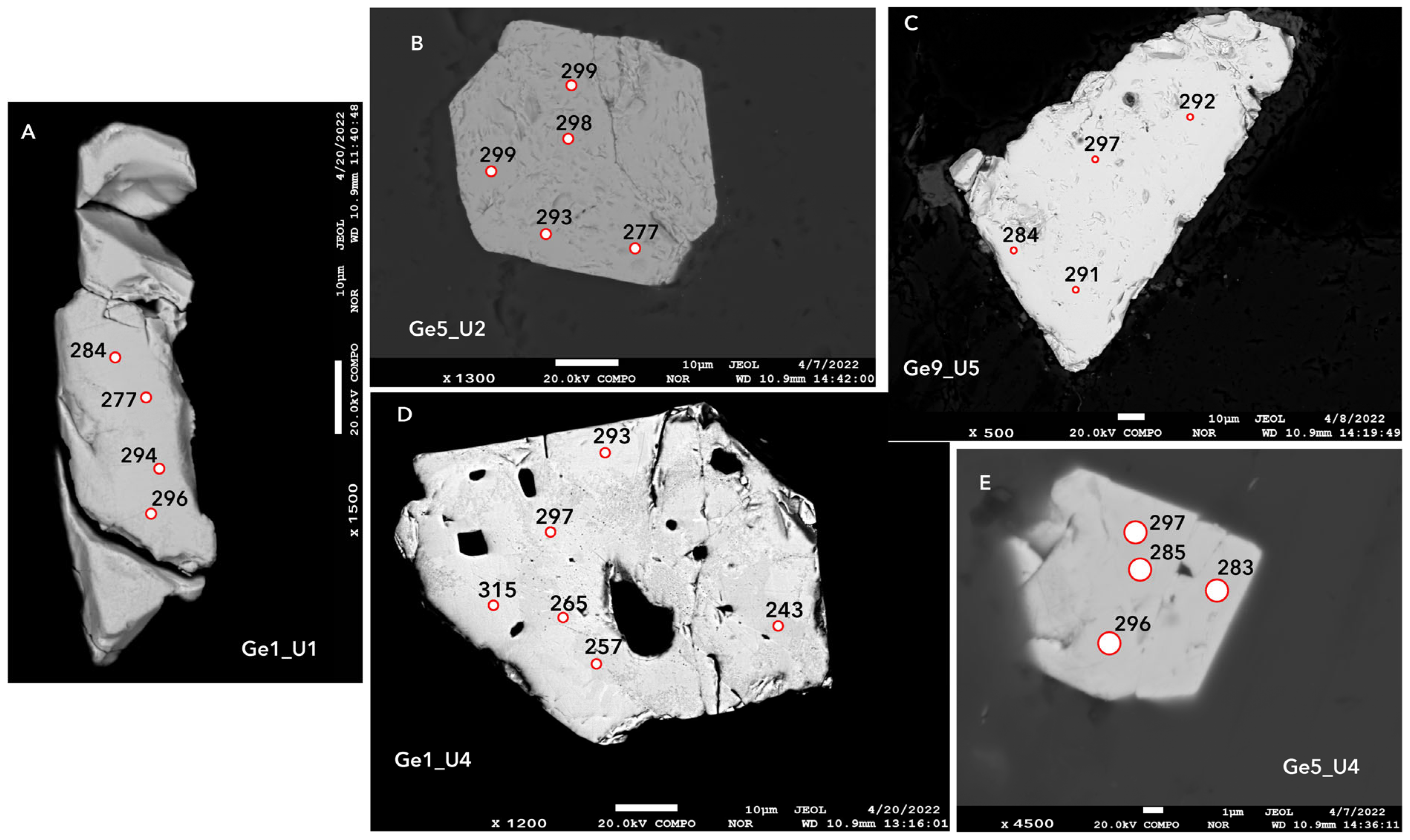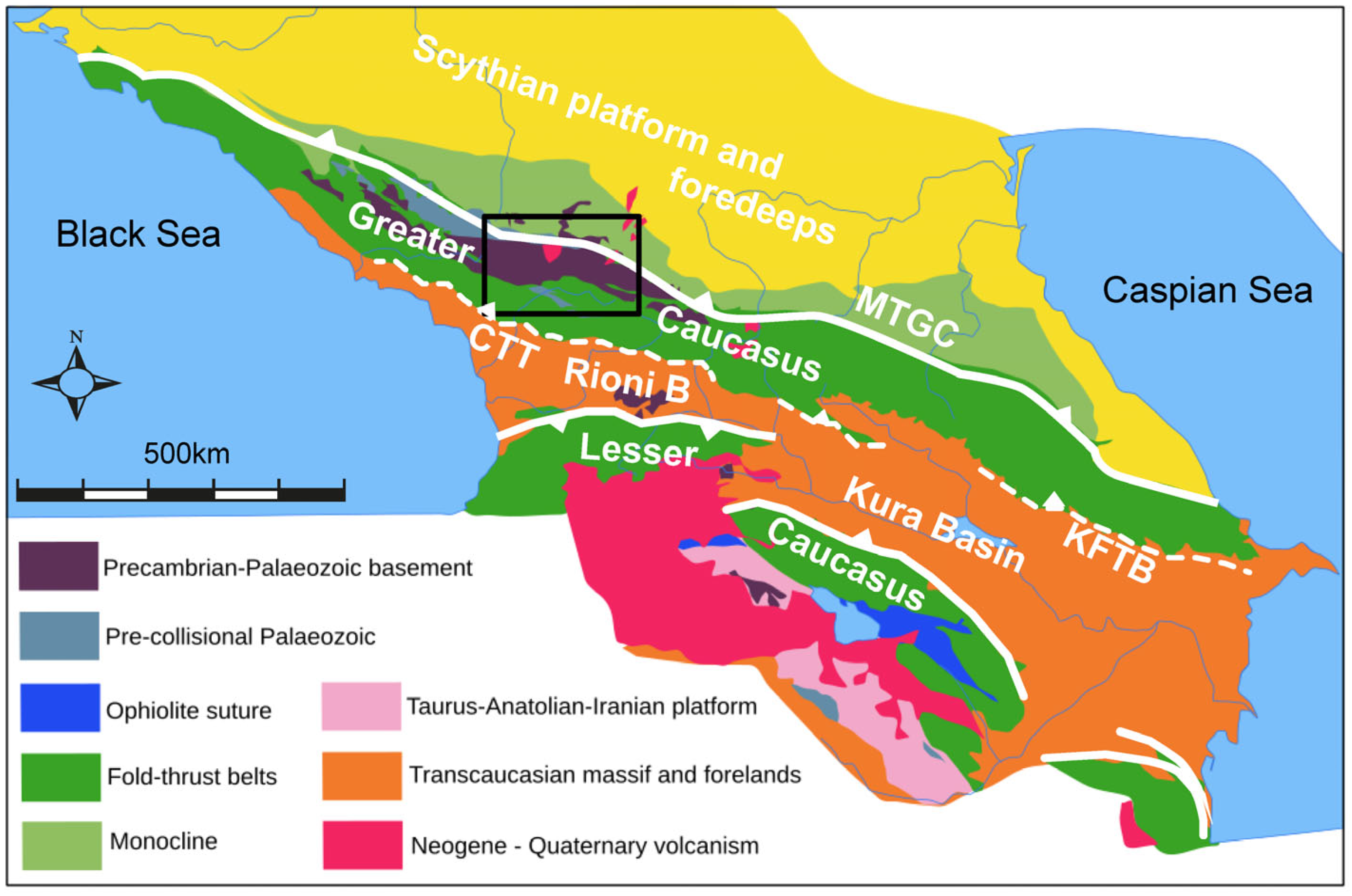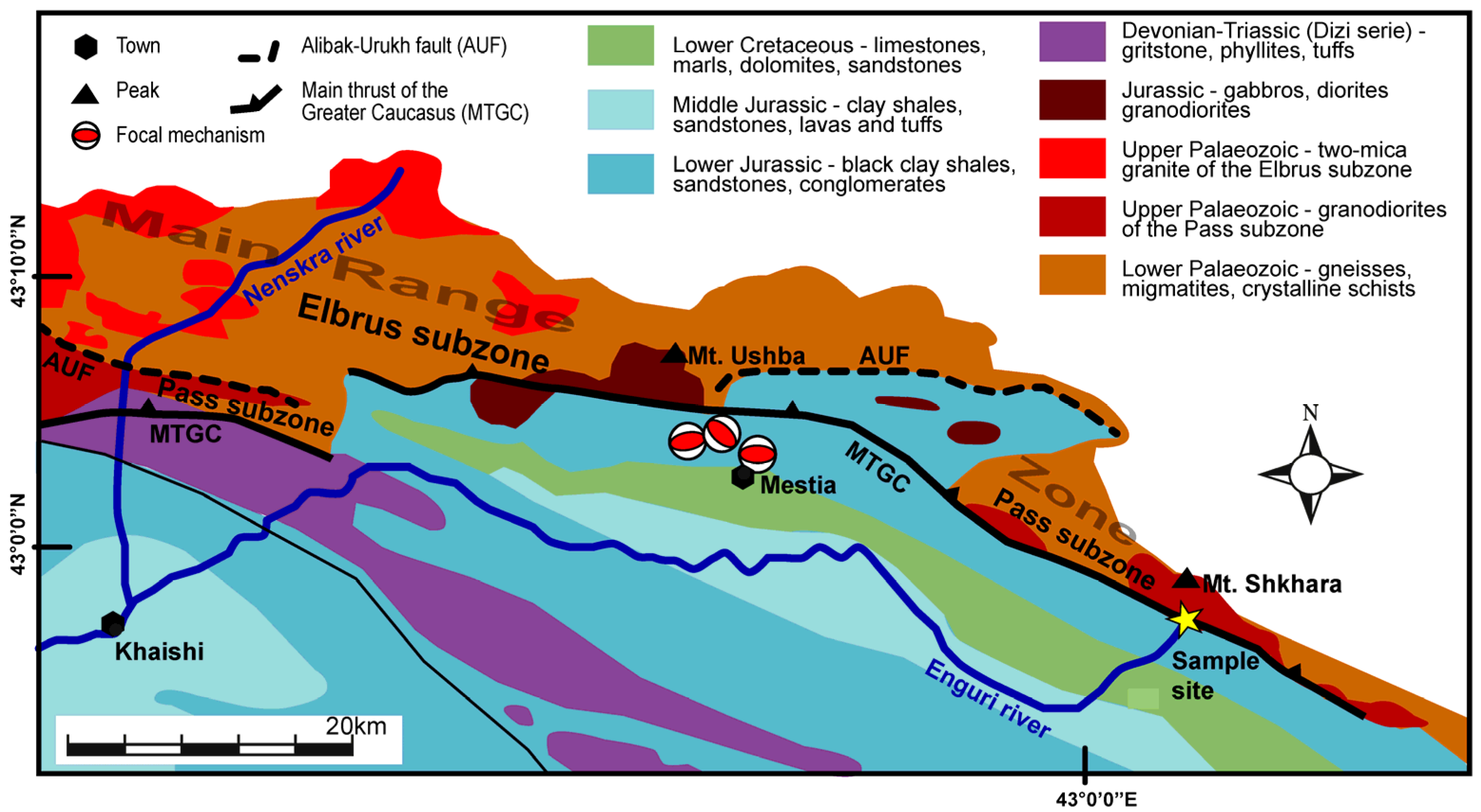Geochemistry and Th–U–Total Pb Chemical Ages of Late Variscan Uranium Mineralisation at Shkhara, Greater Caucasus
Abstract
1. Introduction
2. Geology of the Greater Caucasus Orogenic Belt
3. Uranium Mineralisation Occurrence in the Shkhara Massif
4. Materials and Methods
4.1. Dose Measurements of U-Bearing Biotite and Plagioclase-Rich Granites
4.2. Electron Microprobe Measurements
4.3. Chemical vs. Isotopic Dating: A Brief Summary
5. Results
5.1. Uraninite Chemistry


5.2. Uraninite Chemical Age Determination
5.3. REE Pattern of Uraninites
6. Discussion
7. Conclusions
Supplementary Materials
Author Contributions
Funding
Data Availability Statement
Acknowledgments
Conflicts of Interest
Abbreviations
| Ma | million years |
| EPMA | electron probe micro analyses |
| MTGC | main thrust of the Greater Caucasus |
| LA-ICP-MS | laser ablation-inductively coupled plasma-mass spectrometry |
| Fig | figure |
| BSE/COMPO | backscatter image/composition image |
| Wt% ppm | weight percent parts per million, here in “weight-ppm”, 100 ppm = 0.01 wt% |
| PET/PETL | (large) poly ethylene terephthalate (diffracting crystal) |
| nA | nano Ampere |
| kV | kilo voltage |
References
- Romer, R.L.; Cuney, M. Phanerozoic uranium mineralization in Variscan Europe—More than 400 Ma of tectonic, supergene, and climate-controlled uranium redistribution. Ore Geol. Rev. 2018, 102, 474–504. [Google Scholar] [CrossRef]
- Wang, Z.; Song, H.; Chen, Y.; Song, J.; Hou, M.; Li, Q.; Du, Q.; Yu, H. Uranium resource of Europe: Development status, metallogenic provinces and geodynamic setting. Energy Strategy Rev. 2024, 54, 101467. [Google Scholar] [CrossRef]
- Ballouard, C.; Poujol, M.; Boulvais, P.; Mercadier, J.; Tartèse, R.; Venneman, T.; Deloule, E.; Jolivet, M.; Kéré, I.; Cathelineau, M.; et al. Magmatic and hydrothermal behavior of uranium in syntectonic leucogranites: The uranium mineralization associated with the Hercynian Guerande granite (Armorican Massif, France). Ore Geol. Rev. 2017, 80, 309–331. [Google Scholar] [CrossRef]
- Bonnetti, C.; Liu, X.; Mercadier, J.; Cuney, M.; Deloule, E.; Villeneuve, J.; Liu, W. The genesis of granite-related hydrothermal uranium deposits in the Xiazhuang and Zhuguang ore fields, North Guangdong Province, SE China: Insights from mineralogical, trace elements and U-Pb isotopes signatures of the U mineralization. Ore Geol. Rev. 2018, 92, 588–612. [Google Scholar] [CrossRef]
- René, M. Uranium hydrothermal deposits. In Uranium: Characteristics, Occurrence and Human Exposure; Vasiliev, A.Y., Sidorov, M., Eds.; Nova Science Publishers Incorporated: Hauppauge, NY, USA, 2012; pp. 211–244. [Google Scholar]
- López-Moro, F.J.; Romer, L.R.; Rhede, D.; Fernandez, A.; Timón-Sánchez, S.M.; Moro, M.C. Early uranium mobilization in late Variscan strke-slip shear zones affecting leucogranites of central western Spain. J. Iber. Geol. 2019, 5, 247–257. [Google Scholar] [CrossRef]
- Cuney, M. Felsic magmatism and uranium deposits. Bull. Soc. Geol. Fra. 2014, 185, 75–92. [Google Scholar] [CrossRef]
- Pagel, M.; Ruhlmann, F. Mineralogie et inclusions fluides dans les formations filoniennes mineralisees (Cu, Mo, Ag, U) du secteur de Chateau-Lambert (Vosges Meridionales). Bull. Minéral. 1979, 102, 654–664. [Google Scholar] [CrossRef]
- Hofmann, B.; Eikenberg, J. The Krunkelbach uranium deposit, Schwartzwald, Germany; correlation of radiometric ages (U-Pb, U-Xe-Kr, K-Ar, 230 Th- 234 U). Econ. Geol. 1991, 86, 1031–1049. [Google Scholar] [CrossRef]
- Pfaff, K.; Romer, R.L.; Markl, G. U-Pb ages of ferberite, chalcedony, agate, ‘U-mica’ and pitchblende: Constraints on the mineralization history of the Schwarzwald ore district. Eur. J. Miner. 2009, 21, 817–836. [Google Scholar] [CrossRef]
- Dolníček, Z.; René, M.; Hermannová, S.; Prochaska, W. Origin of the Okrouhlá Radouň episyenite—Hosted uranium deposit, Bohemian Massif, Czech Republic: Fluid inclusion and stable isotope constraints. Miner. Depos. 2013, 49, 409–425. [Google Scholar] [CrossRef]
- Bernard-Griffiths, J.; Peucat, J.J.; Sheppard, S.; Vidal, P. Petrogenesis of Hercynian leucogranites from the southern Armorican Massif: Contribution of REE and isotopic (Sr, Nd, Pb and O) geochemical data to the study of source rock characteristics and ages. Earth Planet. Sci. Lett. 1985, 74, 235–250. [Google Scholar] [CrossRef]
- Cathelineau, M.; Boiron, M.C.; Holliger, P.; Poty, B. Metallogenesis of the French part of the Variscan orogen. Part II: Time-space relationships between U, Au and Sn–W ore deposition and geodynamic events—Mineralogical and U–Pb data. Tectonophysics 1990, 177, 59–79. [Google Scholar] [CrossRef]
- Förster, H.-J.; Rhede, D.; Stein, H.J.; Romer, R.L.; Tischendorf, G. Paired uraninite and molybdenite dating of the Königshain granite: Implications for the onset of late-Variscan magmatism in the Lausitz Block. Int. J. Earth Sci. 2012, 101, 57–67. [Google Scholar] [CrossRef]
- Kroner, U.; Romer, R.L. The Saxo-Thuringian Zone–tip of the Armorican spur and part of the Gondwana plate. In Pre-Mesozoic Geology of Saxo-Thuringia–from the Cadomian Active Margin to the Variscan Orogen; Linnemann, U., Romer, R.L., Eds.; Schweizerbart Stuttgart: Johannesstr, Germany, 2010; pp. 371–394. [Google Scholar]
- Okrostsvaridze, A.; Bluashvili, D.; Gogoladze, S.; Gabrielashvili, R. The discovery of U mineralization in the late Variscan plagiogranite vein of the Shkhara Crystalline Massif (Greater Caucasus, Georgia). Geol. Balc. 2022, 51, 3–14. [Google Scholar] [CrossRef]
- Cowgill, E.; Forte, A.M.; Niemi, N.; Avdeev, B.; Tye, A.; Trexler, C.; Zurab, J.; Mikheil, E.; Godoladze, T. Relict basin closure and crustal shortening budgets during continental collision: An example from Caucasus sediment provenance. Tectonics 2016, 35, 2918–2947. [Google Scholar] [CrossRef]
- Reilinger, R.; McClusky, S.; Vernant, P.; Lawrence, S.; Ergintav, S.; Cakmak, R.; Karam, G. GPS constraints on continental deformation in the Africa-Arabia-Eurasia continental collision zone and implications for the dynamics of plate interactions. J. Geophys. Res. Solid Earth 2006, 111, B05411. [Google Scholar] [CrossRef]
- Adamia, S.; Zakariadze, G.; Chkhotua, T.; Sadradze, N.; Tsereteli, N.; Chabukiani, A.; Gventsadze, A. Geology of the Caucasus: A review. Turk. J. Earth Sci. 2011, 20, 489–544. [Google Scholar] [CrossRef]
- Zonenshain, L.P.; Pichon, X. Deep basins of the Black Sea and Caspian Sea as remnants of Mesozoic back-arc basins. Tectonophysics 1986, 123, 181–211. [Google Scholar] [CrossRef]
- Vincent, S.J.; Morton, A.C.; Carter, A.; Gibbs, S.; Barabadze, T.G. Oligocene uplift of the Western Greater Caucasus: An effect of initial Arabia–Eurasia collision. Terra Nova 2007, 19, 160–166. [Google Scholar] [CrossRef]
- Avdeev, B.; Niemi, N.A. Rapid Pliocene exhumation of the central Greater Caucasus constrained by low-temperature thermochronometr. Tectonics 2011, 30, TC2009. [Google Scholar] [CrossRef]
- Okrostsvaridze, A.; Lee, Y.-H.; Tormey, D.; Skhirtladze, I. U-Pb zircon chronological constraints for three stages of syn-orogenic plutonic magmatism of the Greater Caucasus Svaneti segment, Georgia. Episodes 2023, 46, 195–209. [Google Scholar] [CrossRef]
- Forte, A.M.; Cowgill, E.; Whipple, K.X. Transition from a singly vergent to doubly vergent wedge in a young orogen: The Greater Caucasus. Tectonics 2014, 33, 2077–2101. [Google Scholar] [CrossRef]
- Forte, A.M.; Cowgill, E.; Bernardin, T.; Kreylos, O.; Hamann, B. Late Cenozoic deformation of the Kura fold-thrust belt, southern Greater Caucasus. Geol. Soc. Am. Bull. 2010, 122, 465–486. [Google Scholar] [CrossRef]
- Natal’in, B.A.; Şengör, A.M. Late Palaeozoic to Triassic evolution of the Turan and Scythian platforms: The pre-history of the Paleo-Tethyan closure. Tectonophysics 2005, 404, 175–202. [Google Scholar] [CrossRef]
- Saintot, A.; Stephenson, R.A.; Stovba, S.; Brunet, M.F.; Yegorova, T.; Starostenko, V. The Evolution of the Southern Margin of Eastern Europe (Eastern European and Scythian Platforms) from the Latest Precambrian-Early Palaeozoic to the Early Cretaceous; Geological Society, Memoirs 32: London, UK, 2006; pp. 481–505. [Google Scholar] [CrossRef]
- Forte, A.M.; Cowgill, E.; Murtuzayev, I.; Kangarli, T.; Stoica, M. Structural geometries and magnitude of shortening in the eastern Kura fold-thrust belt, Azerbaijan: Implications for the development of the Greater Caucasus Mountains. Tectonics 2013, 32, 688–717. [Google Scholar] [CrossRef]
- Mellors, R.J.; Jackson, J.; Myers, S.; Gok, R.; Priestley, K.; Yetirmishli, G.; Godoladze, T. Deep earthquakes beneath the Northern Caucasus: Evidence of active or recent subduction in western Asia. Bull. Seismol. Soc. Am. 2012, 102, 862–866. [Google Scholar] [CrossRef]
- Banks, C.J. Regional and Petroleum Geology of the Black Sea and Surrounding Region; AAPG Memoir: Tulsa, OK, USA, 1997. [Google Scholar]
- Rhede, D.; Wendt, I.; Förster, H.J. A three-dimensional method for calculating independent chemical U/Pb-and Th/Pb-ages of accessory minerals. Chem. Geol. 1996, 130, 247–253. [Google Scholar] [CrossRef]
- Förster, H.J. The chemical composition of uraninite in Variscan granites of the Erzgebirge, Germany. Mineral. Mag. 1999, 63, 239–252. [Google Scholar] [CrossRef]
- Montel, J.-M.; Foret, S.; Veschambre, M.; Nicollet, C.; Provost, A. Electron microprobe dating of monazite. Chem. Geol. 1996, 131, 37–53. [Google Scholar] [CrossRef]
- Armstrong, J.T. CITZAF: A package of correction programs for the quantitative electron microbeam X-ray-analysis of thick polished materials, thin-films, and particles. Microbeam Anal. 1995, 4, 177–200. [Google Scholar]
- Kempe, U. Precise electron microprobe age determination in altered uraninite: Consequences on the intrusion age and the metallogenic significance of the Kirchberg granite (Erzgebirge, Germany). Contrib. Mineral. Petr. 2003, 145, 107–118. [Google Scholar] [CrossRef]
- Janeczek, J.; Ewing, R.C. Structural formula of uraninite. J. Nucl. Mater. 1992, 190, 128–132. [Google Scholar] [CrossRef]
- Bowles, J.F. Age dating of individual grains of uraninite in rocks from electron microprobe analyses. Chem. Geol. 1990, 83, 47–53. [Google Scholar] [CrossRef]
- Romer, R.L.; Thomas, R.; Stein, H.J.; Rhede, D. Dating multiply overprinted Sn-mineralized granite–examples from the Erzgebirge, Germany. Miner. Depos. 2007, 42, 337–359. [Google Scholar] [CrossRef]
- Alexandre, P.; Kyser, T.K. Effects of cation substitutions and alteration in uraninite, and implications for the dating of uranium deposits. Can. Min. 2005, 43, 1005–1017. [Google Scholar] [CrossRef]
- Dahlkamp, F.J. Uranium ore Deposits; Springer: Berlin/Heidelberg, Germany, 1993. [Google Scholar]
- Janeczek, J. Mineralogy and geochemistry of natural fission reactors in Gabon. Rev. Min. 1999, 38, 321–392. [Google Scholar]
- Anthony, J.W.; Bideaux, R.A.; Bladh, K.W.; Nichols, M.C. Uraninite. In Handbook of Mineralogy; Mineralogical Society of America: Chantilly, WV, USA, 1990; pp. 67–85. [Google Scholar]
- Mercadier, J.; Cuney, M.; Lach, P.; Boiron, M.-C.; Bonhoure, J.; Richard, A.; Leisen, M.; Kister, P. Origin of uranium deposits revealed by their rare earth element signature. Terra Nova 2011, 23, 264–269. [Google Scholar] [CrossRef]
- Frimmel, H.E.; Schedel, S.; Brätz, H. Uraninite chemistry as forensic tool for provenance analysis. Appl. Geochem. 2014, 48, 104–121. [Google Scholar] [CrossRef]
- Alexandre, P.; Kyser, K.; Layton-Matthews, D.; Joy, B. Chemical composition of natural uraninite. Can. Min. 2015, 53, 595–622. [Google Scholar] [CrossRef]
- Anders, E.; Grevesse, N. Abundances of the elements: Meteoric and solar. Geochim. Cosmochim. Acta 1989, 53, 197–214. [Google Scholar] [CrossRef]
- Rolland, Y. Caucasus collisional history: Review of data from East Anatolia to West Iran. Gondwana. Res. 2017, 49, 130–146. [Google Scholar] [CrossRef]
- Perchuk, A.; Philippot, P. Rapid cooling and exhumation of eclogitic rocks from the Great Caucasus, Russia. J. Metamorp. Geol. 1997, 15, 299–310. [Google Scholar] [CrossRef]






| Element Oxide. | Ge1 (N = 22) | DL [ppm] | Ge5 (N = 21) | DL [ppm] | Ge9 (N = 12) | DL [ppm] | Cannon Std | ||||||
|---|---|---|---|---|---|---|---|---|---|---|---|---|---|
| Min | Average | Max | Average | Min | Average | Max | Average | Min | Average | Max | Average | ||
| SiO2 | 0.00 | 0.01 | 0.03 | 94 | 0.00 | 0.11 | 0.61 | 90 | 0.00 | 0.01 | 0.07 | 91 | 0.04 |
| FeO | 0.00 | 0.08 | 0.32 | 111 | 0.00 | 0.23 | 0.87 | 111 | 0.00 | 0.01 | 0.04 | 111 | 0.02 |
| Ce2O3 | 0.10 | 0.24 | 0.35 | 238 | 0.09 | 0.23 | 0.55 | 240 | 0.18 | 0.27 | 0.45 | 239 | 0.00 |
| La2O3 | 0.00 | 0.02 | 0.08 | 266 | 0.00 | 0.02 | 0.08 | 267 | 0.00 | 0.04 | 0.09 | 265 | 0.04 |
| Sm2O3 | 0.03 | 0.19 | 0.30 | 351 | 0.01 | 0.20 | 0.43 | 353 | 0.07 | 0.19 | 0.36 | 352 | 0.03 |
| Gd2O3 | 0.11 | 0.26 | 0.46 | 357 | 0.00 | 0.32 | 0.82 | 357 | 0.00 | 0.22 | 0.44 | 357 | 0.06 |
| Ho2O3 | 0.00 | 0.06 | 0.17 | 364 | 0.00 | 0.10 | 0.21 | 364 | 0.03 | 0.08 | 0.16 | 362 | 0.00 |
| Er2O3 | 0.14 | 0.27 | 0.60 | 375 | 0.06 | 0.32 | 0.66 | 375 | 0.08 | 0.24 | 0.41 | 374 | 0.02 |
| Yb2O3 | 0.11 | 0.22 | 0.48 | 200 | 0.08 | 0.22 | 0.43 | 200 | 0.15 | 0.23 | 0.35 | 200 | 0.02 |
| UO2 | 78.82 | 81.05 | 83.11 | 335 | 71.69 | 79.69 | 82.25 | 332 | 79.53 | 80.80 | 82.36 | 333 | 100.05 |
| PbO | 2.95 | 3.57 | 3.98 | 186 | 3.12 | 3.49 | 3.72 | 184 | 3.32 | 3.57 | 3.83 | 185 | 0.00 |
| Pr2O3 | 0.00 | 0.06 | 0.14 | 371 | 0.00 | 0.04 | 0.11 | 371 | 0.01 | 0.10 | 0.17 | 370 | 0.00 |
| Nd2O3 | 0.20 | 0.36 | 0.54 | 324 | 0.20 | 0.33 | 0.61 | 322 | 0.28 | 0.42 | 0.75 | 323 | 0.01 |
| Tb2O3 | 0.00 | 0.05 | 0.14 | 341 | 0.00 | 0.06 | 0.21 | 341 | 0.00 | 0.04 | 0.11 | 340 | 0.00 |
| Dy2O3 | 0.17 | 0.34 | 0.57 | 347 | 0.07 | 0.51 | 1.10 | 346 | 0.16 | 0.32 | 0.53 | 348 | 0.00 |
| Lu2O3 | 0.01 | 0.04 | 0.09 | 197 | 0.00 | 0.05 | 0.12 | 196 | 0.01 | 0.05 | 0.08 | 197 | 0.00 |
| P2O5 | 0.00 | 0.00 | 0.04 | 140 | 0.00 | 0.01 | 0.05 | 138 | 0.00 | 0.02 | 0.05 | 141 | 0.00 |
| CaO | 0.00 | 0.20 | 0.49 | 84 | 0.00 | 0.25 | 0.99 | 84 | 0.10 | 0.37 | 0.69 | 85 | 0.00 |
| Y2O3 | 0.85 | 1.71 | 3.77 | 206 | 0.40 | 2.03 | 4.63 | 204 | 0.84 | 1.67 | 2.68 | 207 | 0.00 |
| ThO2 | 6.44 | 7.49 | 8.41 | 350 | 5.70 | 6.89 | 9.47 | 349 | 6.37 | 7.25 | 7.87 | 354 | 0.01 |
| Total | 94.91 | 96.23 | 97.19 | 92.91 | 95.11 | 97.18 | 94.77 | 95.89 | 97.88 | 100.30 | |||
| Ages [Ma] | 243 | 288 | 317 | 272 | 287 | 299 | 273 | 290 | 305 | ||||
Disclaimer/Publisher’s Note: The statements, opinions and data contained in all publications are solely those of the individual author(s) and contributor(s) and not of MDPI and/or the editor(s). MDPI and/or the editor(s) disclaim responsibility for any injury to people or property resulting from any ideas, methods, instructions or products referred to in the content. |
© 2025 by the authors. Licensee MDPI, Basel, Switzerland. This article is an open access article distributed under the terms and conditions of the Creative Commons Attribution (CC BY) license (https://creativecommons.org/licenses/by/4.0/).
Share and Cite
Wilke, F.D.H.; Okrostsvaridze, A.; Bluashvili, D.; Gabrielashvili, R. Geochemistry and Th–U–Total Pb Chemical Ages of Late Variscan Uranium Mineralisation at Shkhara, Greater Caucasus. Minerals 2025, 15, 960. https://doi.org/10.3390/min15090960
Wilke FDH, Okrostsvaridze A, Bluashvili D, Gabrielashvili R. Geochemistry and Th–U–Total Pb Chemical Ages of Late Variscan Uranium Mineralisation at Shkhara, Greater Caucasus. Minerals. 2025; 15(9):960. https://doi.org/10.3390/min15090960
Chicago/Turabian StyleWilke, Franziska D. H., Avtandil Okrostsvaridze, David Bluashvili, and Rabi Gabrielashvili. 2025. "Geochemistry and Th–U–Total Pb Chemical Ages of Late Variscan Uranium Mineralisation at Shkhara, Greater Caucasus" Minerals 15, no. 9: 960. https://doi.org/10.3390/min15090960
APA StyleWilke, F. D. H., Okrostsvaridze, A., Bluashvili, D., & Gabrielashvili, R. (2025). Geochemistry and Th–U–Total Pb Chemical Ages of Late Variscan Uranium Mineralisation at Shkhara, Greater Caucasus. Minerals, 15(9), 960. https://doi.org/10.3390/min15090960








